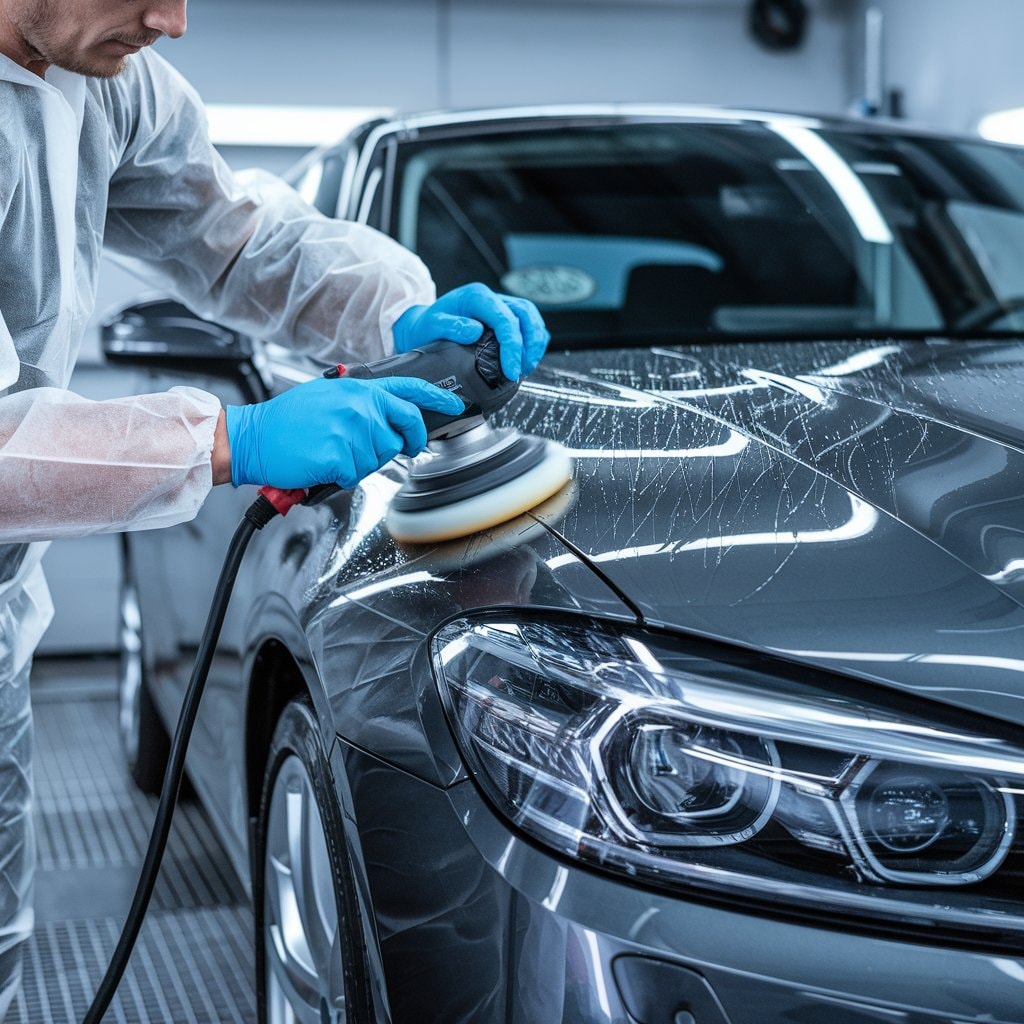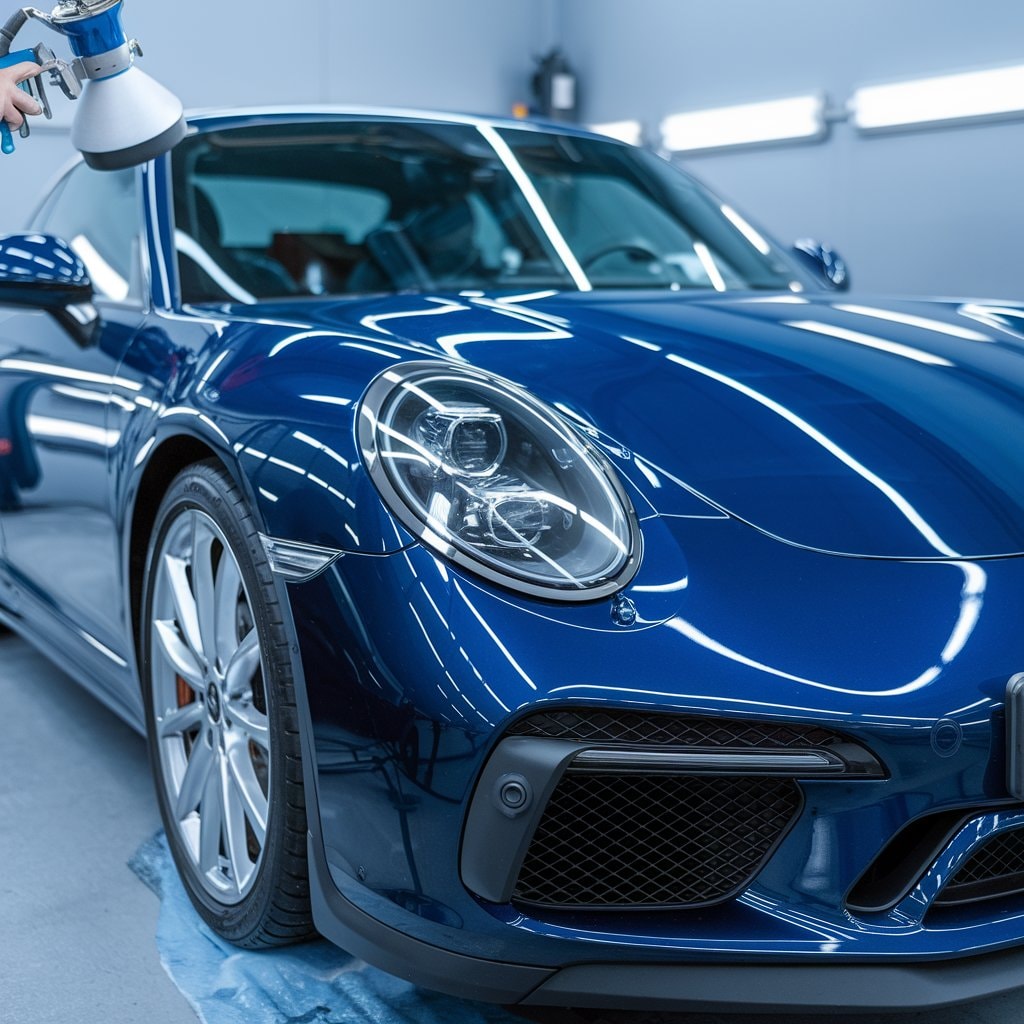Applying a nano-ceramic coating for a long-lasting effect starts by thoroughly cleansing the car’s surface and removing contaminants. Follow with paint correction techniques and a final wipe-down using isopropyl alcohol. Apply the coating evenly, allowing each layer to cure completely before adding another. Verify the application takes place in a calm, shaded environment and allows adequate curing time. Proper application and maintenance guarantee enhanced durability and protection, revealing more profound insights into sustaining the coat’s pristine condition.
What is nano ceramic coating, and why should you use it?
Nano ceramic coating offers enhanced vehicle protection by forming a long-lasting, water-repellent layer that shields against contaminants.
Unlike traditional wax, which provides a softer and less durable barrier, ceramic coatings bond at a molecular level for longer-lasting protection.
This technology preserves the car’s appearance and reduces the frequency of washes needed, making it an advantageous choice for car maintenance.
Benefits of nano-ceramic coatings for your car’s protection
A nano ceramic coating offers a revolutionary layer of protection for vehicles by employing nanotechnology to create a durable, chemically bonded surface.
This ceramic coating is a protective barrier for a car’s paint, enhancing its durability against environmental hazards such as UV rays, acid rain, chemical stains, and salt.
The superior protection provided by nano ceramic coatings guarantees long-lasting protection, preserving the integrity and appearance of the paint surface.
The intricate composition of the coating also contributes to its effectiveness in shielding the vehicle from minor abrasions and scratches, offering a robust defense that maintains the car’s aesthetic appeal.
How nano ceramic coatings provide a hydrophobic layer
Building on the robust protection offered by nano ceramic coatings, one of their most impressive features is their ability to provide a hydrophobic surface.
When individuals apply the nano-ceramic coating, the ceramic coating product forms a hydrophobic layer that excels at repelling water and more dirt. This characteristic considerably enhances the efficacy and longevity of the car coating.
As the coating bonds chemically with the vehicle’s surface, it guarantees long-lasting protection against environmental contaminants. This maintains the car’s aesthetic appeal and makes cleaning tasks much more manageable.
Comparison of ceramic coating and traditional wax
Understanding the distinction between ceramic coating and traditional wax is essential for anyone seeking the most effective protection for their vehicle’s exterior.
Ceramic coatings provide a robust barrier against environmental hazards, unlike car waxes, which often require more frequent applications. While traditional wax offers a glossy shine and some protection, it lacks the durability of ceramic coatings.
Key differences include:
- Durability: Ceramic coating forms a more complex, longer-lasting layer than traditional wax.
- Protection: Offers superior defense against UV rays and contaminants.
- Maintenance: There is a less frequent need for reapplication than car wax.
Applying ceramic coating involves a more meticulous process but produces a stronger shield than paint sealants or car waxes, making it a wise choice for lasting exterior maintenance.
How to apply nano ceramic coating to your car: Step-by-step guide
Applying nano ceramic coating begins with meticulous preparation of the car’s surface.
Essential tools such as a microfiber cloth and a clay bar are critical in ensuring the surface is flawless before application.
Proper ceramic coating technique is crucial for achieving a durable and aesthetically pleasing finish.

Preparing your car’s surface for coating application
Preparing your car’s surface for a nano-ceramic coating is an essential step that guarantees the ideal adhesion and performance of the protective layer. The process involves thoroughly cleansing and refining the car’s surface to ensure it is free from any impurities that may hinder the protective coating’s effectiveness.
- Clay Bar Treatment: Use a clay bar with a suitable lubricant to remove dirt and contaminants undetectable to the naked eye.
- Paint Correction: To achieve a smooth surface, address swirl marks and minor scratches using paint correction techniques.
- Final Cleansing: Wipe the car with isopropyl alcohol and a microfiber cloth to remove any residual polishing oils, ensuring a pristine surface for coating application.
Using the right tools: microfiber cloth and clay bar
Selecting the appropriate tools is essential for effectively applying a nano-ceramic coating to your car. A microfiber cloth is indispensable for this process, as its fine fibers are gentle on the car’s surface yet effective in removing residues without scratching the paint.
Additionally, a clay bar is vital before you apply nano ceramic; it meticulously cleans the surface by removing minute particles and contaminants that a regular wash cannot. This guarantees that the car ceramic coating adheres appropriately and evenly, creating a more durable and glossy finish.
Using a microfiber cloth and a clay bar prepares the surface most effectively, setting the stage for a successful ceramic coating application.
Applying the ceramic coating product correctly
Once the car’s surface has been meticulously prepared using a microfibre cloth and a clay bar, the next step is precisely applying the nanoceramic coating.
To apply the coating effectively:
- Follow the manufacturer’s instructions carefully to guarantee the ceramic coating product is used correctly.
- Apply a ceramic coating evenly across the surface to avoid any uneven spots that could affect the coating’s longevity and appearance.
- Allow the first layer to completely dry before considering the application of a second coat, adhering to the recommended curing time to confirm the coating has been set correctly.
Achieving a superior ceramic coating application involves patience and precision, allowing the coating to cure fully for maximum protection and shine.
What are the best practices for applying ceramic coating?
Proper curing is critical to guarantee long-lasting results from a nano-ceramic coating.
It is equally important to recognize and avoid common application errors that can compromise the effectiveness of the coating.
Additionally, understanding how ceramic coatings shield a vehicle’s surface from UV damage can be beneficial for maintaining the integrity of the paint over time.
How to cure the coating for long-lasting results
Curing the nano ceramic coating properly is essential for achieving long-lasting results and enhancing the durability of the vehicle’s surface.
After applying nano ceramic coating, it is vital to allow the car’s paint to cure correctly to guarantee maximum bond strength and performance.
Here are some key practices:
- Temperature and Environment: Cure the coating in a regulated setting with stable temperatures and minimal humidity.
- Time: Allow the coating to cure for at least 24 hours without exposure to water or contaminants.
- Maintenance: Regularly wash the car using proper car wash soap to preserve the ceramic coating’s integrity.
These steps will guarantee the ceramic coating application provides adequate protection and maintains the car’s aesthetic appeal.
Common mistakes to avoid while applying nano ceramic
While applying nano ceramic coating, specific common errors can significantly undermine the effectiveness and longevity of the protective layer.
One critical mistake is failing to apply the nano ceramic coating evenly, leading to uneven protection, light scratches, and a less appealing finish. To guarantee uniform application, use a foam block in a circular motion, promoting a smooth polishing finish.
Another frequent error is using car shampoo or cleaners that contain harsh chemicals before the application; these can interfere with the bonding process of the coating.
Additionally, avoid applying the coating under direct sunlight or in extreme temperatures. Instead, choose a calm environment, which helps prevent premature drying and guarantees better adhesion and durability of the layer.
How ceramic coatings provide UV protection
Nano ceramic coatings offer considerable protection against ultraviolet (UV) radiation, a key benefit for maintaining the integrity and appearance of vehicle paint.
When applied, these coatings form a strong bond with the car’s paint and window glass, creating a resilient barrier that diminishes the harmful effects of UV rays. This added layer protects and extends the life of the clear coat and underlying paint.
Key points to ponder:
- Enhanced UV Resistance: Ceramic coatings reduce paint fading and oxidation due to UV exposure.
- Long-Term Protection: Creates a durable shield that withstands environmental factors beyond just UV rays.
- Preservation of Aesthetics: Helps maintain the glossy appearance of the paint, keeping the vehicle looking newer for longer.
How do you maintain nano ceramic coating for cars?
Maintaining a nano-ceramic coating on a car requires consistent attention to detail.
Regular vehicle washing with appropriate products is essential for preserving the coating’s integrity.
Additionally, using microfiber towels for cleaning and knowing when to reapply the coating are key aspects of adequate maintenance.

The importance of regular car wash after coating
Applying a regular car wash is essential for maintaining the effectiveness of a nano-ceramic coating.
Regular maintenance guarantees that dirt and debris do not compromise the integrity of the new car coating. Washing the car with ceramic shampoo is particularly beneficial as it is designed to work in harmony with the nano ceramic coating pro.
This care helps preserve the two coats applied during the second half of the application process, keeping the car’s surface pristine.
Key points to remember include:
- Use ceramic shampoo. It is designed to complement the chemical properties of the coating.
- Regular washing: Prevents build-up of harmful contaminants.
- Gentle techniques: Avoid abrasive tools that could damage the coating.
Using microfiber towels for car care
Using microfiber towels for car care is critical when maintaining the integrity of a nanoceramic coating. These towels are gentle on the car’s surface, preventing scratches that can compromise the coating’s effectiveness.
Ceramic coatings are a great alternative to traditional waxes, providing a more substantial barrier against environmental contaminants. When applying the nano ceramic coating, It is vital to use a clay bar first to guarantee the surface is impeccably clean and smooth.
After the application, using microfiber towels helps preserve the coating on the car and keeps the alloy wheels and the entire vehicle looking pristine. This practice maintains the aesthetic appeal and keeps the car cleaner for longer.
When reapplying nano ceramic coating
How often should a nano-ceramic coating be reapplied to ensure optimal performance and maximum protection for your vehicle? Typically, the longevity of a professionally applied nano ceramic coating can range from two to five years, depending on various factors, including maintenance and exposure conditions.
To maintain the best condition of your car’s paint, consider these key points:
- Durability: Professional grade coating usually has a stronger bond with the surface, prolonging the interval before reapplication.
- Maintenance Routine: Regular washing and minimal exposure to harsh elements can extend the life of the coating.
- Visual Inspection: Look for signs of wear or diminished water beading, which indicate when to reapply the nano ceramic coating.
Understanding these aspects can help manage ceramic coating cost-effectively while ensuring lasting protection for your car.
What types of nano ceramic coatings are available?
Nano ceramic coatings vary widely in their formulations and purposes, each tailored to meet vehicles’ specific protective and aesthetic needs.
Vehicle owners must choose a coating type that aligns with their car’s requirements and usage conditions.
This selection process involves understanding the distinct properties and benefits of each available ceramic coating product.

Understanding different ceramic coating formulations
Various types of nano ceramic coatings are available on the market, each designed to enhance vehicle protection in specific ways.
These advanced formulations offer superior durability compared to traditional car waxes or sealants. The primary categories include:
- Professional Grade Nano Ceramic Coatings: These top-tier products provide exceptional longevity and hardness, often requiring application by certified professionals.
- Glass Coating: This type of nano ceramic focuses on enhancing the glass-like appearance and clarity while providing substantial resistance against environmental contaminants.
- New Ceramic Coating Technologies: Innovations in nano-ceramic coatings that offer more straightforward application and enhanced performance characteristics, making them suitable for DIY enthusiasts using car maintenance products.
Each type of nano ceramic coating has unique hydrophobic properties tailored to different needs and preferences in vehicle care.
Choosing the right coating product for your car’s needs
Selecting the appropriate nano ceramic coating for your vehicle involves understanding each type’s benefits and limitations. Various nano ceramic coatings are available, each tailored to different aspects of car care.
For those looking to apply a ceramic coating to their car, it’s essential to choose one that best suits the needs of the car’s paint and overall maintenance. Nano ceramic coatings protect your vehicle’s surface from environmental damage while enhancing its aesthetic appeal.
A car owner must use a good quality product to guarantee longevity and effectiveness. The best ceramic coatings offer protection and a robust barrier against contaminants, making them ideal for those prioritizing durability and shine in their vehicle maintenance routine.
Conclusion
In summary, nano ceramic coating offers exceptional protection for car surfaces, enhancing appearance and longevity. Car owners can guarantee peak results by following a meticulous application process and adhering to best practices. Regular maintenance further preserves the coating’s integrity, maximizing its benefits. Selecting the right coating is essential for tailored protection with various types available. Ultimately, the effort invested in applying and maintaining a nano-ceramic coating pays off by keeping the vehicle in pristine condition.






